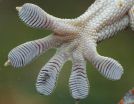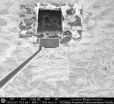(Press-News.org) Harvard neuroscientists have made a discovery that turns 160 years of neuroanatomy on its head.
Myelin, the electrical insulating material long known to be essential for the fast transmission of impulses along the axons of nerve cells, is not as ubiquitous as thought, according to a new work lead by Professor Paola Arlotta of the Harvard Stem Cell Institute (HSCI) and the University's Department of Stem Cell and Regenerative Biology, in collaboration with Professor Jeff Lichtman, of Harvard's Department of Molecular and Cellular Biology.
"Myelin is a relatively recent invention during evolution," says Arlotta. "It's thought that myelin allowed the brain to communicate really fast to the far reaches of the body, and that it has endowed the brain with the capacity to compute higher level functions." In fact, loss of myelin is a feature of a number of devastating diseases, including multiple sclerosis and schizophrenia.
But the new research shows that despite myelin essential roles in the brain, "some of the most evolved, most complex neurons of the nervous system have less myelin than older, more ancestral ones" Arlotta, co-director of the HSCI neuroscience program, says.
What this means, Arlotta says, is that the higher in the cerebral cortex one looks – the closer to the top of the brain, which is its most evolved region - the less myelin one finds. Not only that, but "neurons in this part of the brain display a brand new way of positioning myelin along their axons that has not been previously seen. They have 'intermittent myelin' with long axon tracts that lack myelin interspersed among myelin-rich segments.
Arlotta continues: "contrary to the common assumptions that neurons use a universal profile of myelin distribution on their axons, the work indicate that different neurons choose to myelinate their axons differently. In classic neurobiology textbooks myelin is represented on axons as a sequence of myelinated segments separated by very short nodes that lack myelin. This distribution of myelin was tacitly assumed to be always the same, on every neuron, from the beginning to the end of the axon. This new work finds this not to be the case."
The results of the research by Arlotta and post doctoral fellow Giulio Srubek Tomassy, the first author on the report, are published in the latest edition of Science, the journal of the American Association for the Advancement of Science.
The paper is accompanied by a "Perspective" by R. Douglas Fields, of the Eunice Kennedy Shriver National Institute of Child Health and Human Development, at the National Institutes of Health, who says that Arlotta and Tomassy's findings raise important questions about the purpose of myelin, "are likely to spark new concepts about how information is transmitted and integrated in the brain."
Arlotta and Tomassy collaborated closely on the new work with postdoctoral fellow Daniel Berger of the Lichtman group, which generated one of the two massive electron microscopy data bases that made the work possible.
"The fact that it is the most evolved neurons, the ones that have expanded dramatically in humans, suggests that what we're seeing might be the "future". As neuronal diversity increases and the brain needs to process more and more complex information, neurons change the way they use myelin to "achieve" more", says Arlotta.
It is possible, said Tomassy, that these profiles of myelination "may be giving neurons an opportunity to branch out and 'talk' to neighboring neurons". For example, because axons cannot make synaptic contacts when they are myelinated, a possibility is that these long myelin gaps may be needed to increase neuronal communication and synchronize responses across different neurons. Perhaps, he and Arlotta postulate, the intermittent myelin is intended to fine-tune the electrical impulses traveling along the axons, in order to allow the emergence of highly complex neuronal behaviors.
INFORMATION:
Finding turns neuroanatomy on its head
Harvard researchers present new view of myelin
2014-04-18
ELSE PRESS RELEASES FROM THIS DATE:
Researchers question published no-till soil organic carbon sequestration rates
2014-04-18
URBANA, Ill. For the past 20 years, researchers have published soil organic carbon sequestration rates. Many of the research findings have suggested that soil organic carbon can be sequestered by simply switching from moldboard or conventional tillage systems to no-till systems. However, there is a growing body of research with evidence that no-till systems in corn and soybean rotations without cover crops, small grains, and forages may not be increasing soil organic carbon stocks at the published rates.
"Some studies have shown that both moldboard and no-till systems ...
Sun emits a mid-level solar flare
2014-04-18
The sun emitted a mid-level solar flare, peaking at 9:03 a.m. EDT on April 18, 2014, and NASA's Solar Dynamics Observatory captured images of the event. Solar flares are powerful bursts of radiation. Harmful radiation from a flare cannot pass through Earth's atmosphere to physically affect humans on the ground, however -- when intense enough -- they can disturb the atmosphere in the layer where GPS and communications signals travel.
To see how this event may impact Earth, please visit NOAA's Space Weather Prediction Center at http://spaceweather.gov, the U.S. government's ...
Researchers find 3-million-year-old landscape beneath Greenland ice sheet
2014-04-18
Glaciers and ice sheets are commonly thought to work like a belt sander. As they move over the land they scrape off everything — vegetation, soil and even the top layer of bedrock. So a team of university scientists and a NASA colleague were greatly surprised to discover an ancient tundra landscape preserved under the Greenland Ice Sheet, below two miles of ice.
"We found organic soil that has been frozen to the bottom of the ice sheet for 2.7 million years," said University of Vermont geologist and lead author Paul Bierman. The finding provides strong evidence that the ...
Religious music brings benefit to seniors' mental health
2014-04-18
A new article published online in The Gerontologist reports that among older Christians, listening to religious music is associated with a decrease in anxiety about death and increases in life satisfaction, self-esteem, and sense of control over their lives. In particular, listening to gospel music is associated with a decrease in anxiety about death and an increase in sense of control.
These associations are similar for blacks and whites, women and men, and individuals of both low- and high-socioeconomic status.
The article, titled "Listening to Religious Music and ...
Ancient DNA offers clues to how barnyard chickens came to be
2014-04-18
Durham, NC — Ancient DNA adds a twist to the story of how barnyard chickens came to be, finds a study to be published April 21 in the journal Proceedings of the National Academy of Sciences.
Analyzing DNA from the bones of chickens that lived 200-2300 years ago in Europe, researchers report that just a few hundred years ago domestic chickens may have looked far different from the chickens we know today.
The results suggest that some of the traits we associate with modern domestic chickens -- such as their yellowish skin -- only became widespread in the last 500 years, ...
Plants with dormant seeds give rise to more species
2014-04-18
Durham, NC — Seeds that sprout as soon as they're planted may be good news for a garden. But wild plants need to be more careful. In the wild, a plant whose seeds sprouted at the first
warm spell or rainy day would risk disaster. More than just an insurance policy against late frosts or unexpected dry spells, it turns out that seed dormancy has long-term advantages too: Plants whose seeds put off sprouting until conditions are more certain give rise to more species, finds in a team of researchers working at the National Evolutionary Synthesis Center in North Carolina.
When ...
Gecko-like adhesives now useful for real world surfaces
2014-04-18
AMHERST, Mass. – The ability to stick objects to a wide range of surfaces such as drywall, wood, metal and glass with a single adhesive has been the elusive goal of many research teams across the world, but now a team of University of Massachusetts Amherst inventors describe a new, more versatile version of their invention, Geckskin, that can adhere strongly to a wider range of surfaces, yet releases easily, like a gecko's feet.
"Imagine sticking your tablet on a wall to watch your favorite movie and then moving it to a new location when you want, without the need for ...
'Exotic' material is like a switch when super thin
2014-04-18
ITHACA, N.Y. – Researchers from Cornell University and Brookhaven National Laboratory have shown how to switch a particular transition metal oxide, a lanthanum nickelate (LaNiO3), from a metal to an insulator by making the material less than a nanometer thick.
Ever-shrinking electronic devices could get down to atomic dimensions with the help of transition metal oxides, a class of materials that seems to have it all: superconductivity, magnetoresistance and other exotic properties. These possibilities have scientists excited to understand everything about these materials, ...
New study suggests a better way to deal with bad memories
2014-04-18
What's one of your worst memories? How did it make you feel? According to psychologists, remembering the emotions felt during a negative personal experience, such as how sad you were or how embarrassed you felt, can lead to emotional distress, especially when you can't stop thinking about it.
When these negative memories creep up, thinking about the context of the memories, rather than how you felt, is a relatively easy and effective way to alleviate the negative effects of these memories, a new study suggests.
Researchers at the Beckman Institute at the University ...
Impurity size affects performance of emerging superconductive material
2014-04-18
Research from North Carolina State University finds that impurities can hurt performance – or possibly provide benefits – in a key superconductive material that is expected to find use in a host of applications, including future particle colliders. The size of the impurities determines whether they help or hinder the material's performance.
At issue is a superconductive material called bismuth strontium calcium copper oxide (Bi2212). A superconductor is a material that can carry electricity without any loss – none of the energy is dissipated as heat, for example. Superconductive ...
LAST 30 PRESS RELEASES:
Myeloma: How AI is redrawing the map of cancer care
Manhattan E. Charurat, Ph.D., MHS invested as the Homer and Martha Gudelsky Distinguished Professor in Medicine at the University of Maryland School of Medicine
Insilico Medicine’s Pharma.AI Q4 Winter Launch Recap: Revolutionizing drug discovery with cutting-edge AI innovations, accelerating the path to pharmaceutical superintelligence
Nanoplastics have diet-dependent impacts on digestive system health
Brain neuron death occurs throughout life and increases with age, a natural human protein drug may halt neuron death in Alzheimer’s disease
SPIE and CLP announce the recipients of the 2025 Advanced Photonics Young Innovator Award
Lessons from the Caldor Fire’s Christmas Valley ‘Miracle’
Ant societies rose by trading individual protection for collective power
Research reveals how ancient viral DNA shapes early embryonic development
A molecular gatekeeper that controls protein synthesis
New ‘cloaking device’ concept to shield sensitive tech from magnetic fields
Researchers show impact of mountain building and climate change on alpine biodiversity
Study models the transition from Neanderthals to modern humans in Europe
University of Phoenix College of Doctoral Studies releases white paper on AI-driven skilling to reduce burnout and restore worker autonomy
AIs fail at the game of visual “telephone”
The levers for a sustainable food system
Potential changes in US homelessness by ending federal support for housing first programs
Vulnerability of large language models to prompt injection when providing medical advice
Researchers develop new system for high-energy-density, long-life, multi-electron transfer bromine-based flow batteries
Ending federal support for housing first programs could increase U.S. homelessness by 5% in one year, new JAMA study finds
New research uncovers molecular ‘safety switch’ shielding cancers from immune attack
Bacteria resisting viral infection can still sink carbon to ocean floor
Younger biological age may increase depression risk in older women during COVID-19
Bharat Innovates 2026 National Basecamp Showcases India’s Most Promising Deep-Tech Ventures
Here’s what determines whether your income level rises or falls
SCIE indexation achievement: Celebrate with Space: Science & Technology
Children’s Hospital Colorado performs region’s first pediatric heart and liver dual organ transplant
Australian team discover why quantum computers have memory problems over time
What determines the fate of a T cell?
Candida auris: genetic process revealed which could be treatment target for deadly fungal disease
[Press-News.org] Finding turns neuroanatomy on its headHarvard researchers present new view of myelin






